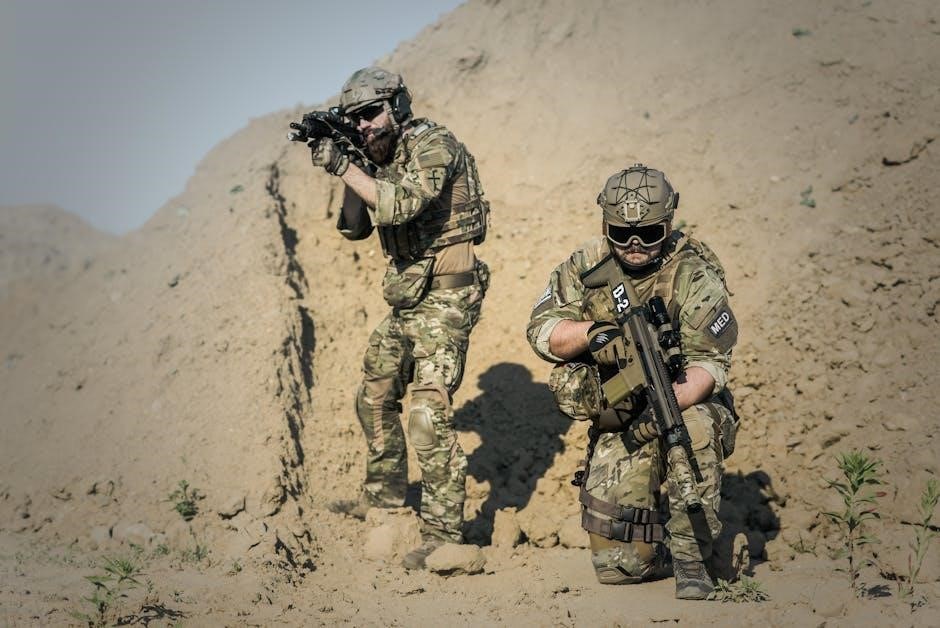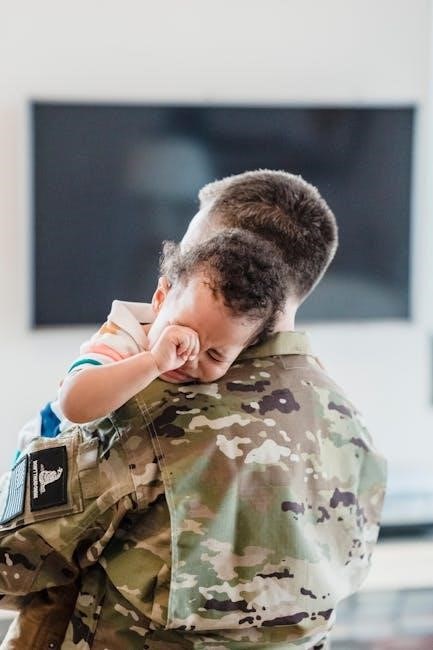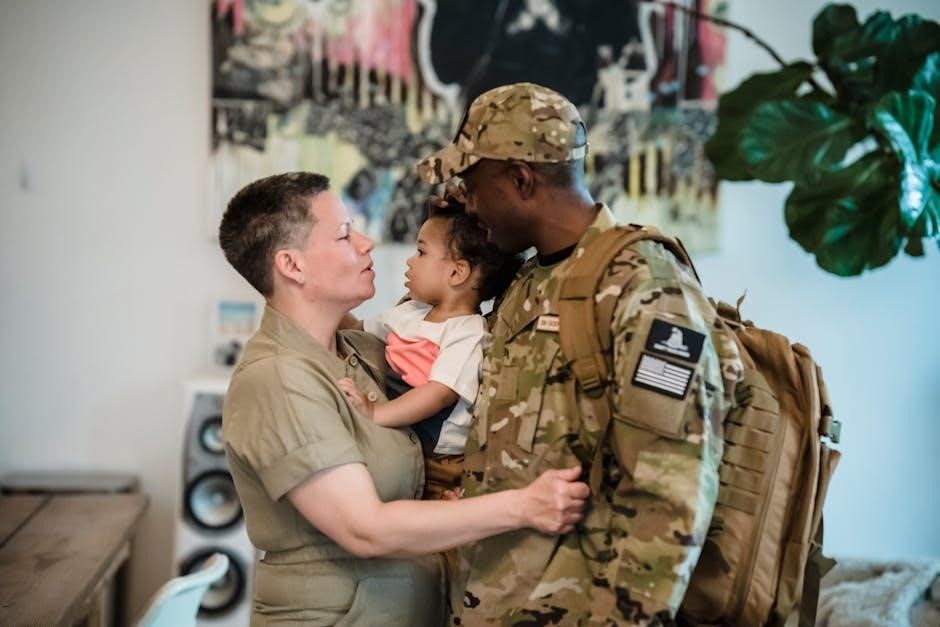The Army OCP Uniform Guide provides essential information on the Operational Camouflage Pattern uniform‚ its proper wear‚ and adherence to Army regulations‚ ensuring discipline and professionalism.
1.1 Overview of the Operational Camouflage Pattern (OCP)
The Operational Camouflage Pattern (OCP) is a six-color‚ multi-environment camouflage design introduced in 2015 to replace the Army Combat Uniform (ACU). Designed to blend into various environments‚ the OCP enhances concealment and versatility. It features a balanced mix of greens‚ browns‚ and tans‚ providing effective camouflage in both garrison and combat settings. The OCP became mandatory for all soldiers on October 1‚ 2019‚ marking a significant update to the Army’s uniform standards for modern operational needs.
1.2 Importance of Uniform Regulations in the Army
Uniform regulations are critical for maintaining discipline‚ professionalism‚ and cohesion within the Army. They ensure all soldiers present a consistent and respectful appearance‚ reflecting the Army’s values. Proper adherence to these standards fosters unit identity and esprit de corps‚ while also upholding the Army’s tradition of excellence. Uniform regulations also ensure safety and functionality in operational environments‚ making them essential for both garrison and combat settings. Compliance with these guidelines is a fundamental aspect of military service.

History and Development of the OCP Uniform
The OCP uniform’s development began in 2015‚ replacing the ACU with enhanced camouflage and functionality‚ aligning with contemporary operational needs and Army regulations.
2.1 Transition from ACU to OCP
The transition from the Army Combat Uniform (ACU) to the Operational Camouflage Pattern (OCP) began in 2015‚ with the OCP becoming mandatory by October 1‚ 2019. The shift addressed the ACU’s Universal Camouflage Pattern‚ which lacked effectiveness in various environments. The OCP offers improved camouflage‚ durability‚ and functionality‚ aligning with modern operational demands. This change ensured uniformity and enhanced practicality for soldiers across diverse mission settings‚ reflecting the Army’s commitment to adaptability and readiness.
2.2 Key Features of the OCP Design
The OCP design introduces an improved Operational Camouflage Pattern‚ replacing the less effective Universal Camouflage Pattern. It features the Scorpion W2 pattern‚ enhancing concealment across various environments. The uniform is crafted with durable‚ high-quality materials for longevity and comfort. Designed for practicality‚ it includes multiple utility pockets and a streamlined fit for mobility. The OCP also incorporates gender-neutral design elements‚ ensuring uniformity for all soldiers. Its color scheme‚ including black and spice brown thread for name tapes and rank‚ aligns with Army standards for cohesion and professionalism.

Army Regulation 670-1 and Uniform Wear
Army Regulation 670-1 governs the wear and appearance of uniforms‚ ensuring consistency‚ professionalism‚ and discipline across all ranks. It provides detailed standards for grooming‚ badges‚ and attire.
3.1 Overview of AR 670-1
Army Regulation 670-1 outlines standards for the wear and appearance of uniforms‚ badges‚ and insignia. It ensures uniformity‚ discipline‚ and professionalism across all ranks. The regulation applies to all active duty‚ reserve‚ and National Guard soldiers‚ detailing grooming standards‚ proper attire‚ and the display of awards. Updated in 2021‚ AR 670-1 includes specific guidelines for the Operational Camouflage Pattern (OCP) uniform‚ ensuring clarity and consistency in military presentation.
3.2 Proper Wear and Appearance Guidelines
Proper wear and appearance of the OCP uniform are crucial for maintaining a professional and disciplined image. Soldiers must ensure their uniform is clean‚ pressed‚ and well-fitted. Jackets should be zipped‚ sleeves rolled neatly‚ and footwear polished. All components‚ including name tapes and rank insignia‚ must be correctly placed. Adherence to these guidelines ensures uniformity and reflects the Army’s standards of excellence and readiness.
3.3 Insignia and Badge Placement
Proper placement of insignia and badges on the OCP uniform is essential for maintaining a professional appearance. Name tapes‚ rank insignia‚ and branch insignia must be centered and aligned correctly. The U.S. Army tape is placed above the name tape on the uniform’s chest. Badges are positioned on the left side‚ with specific spacing guidelines to avoid overcrowding. These standards ensure consistency and adherence to Army regulations‚ promoting a unified and organized look across all ranks.

Authorized Patches and Insignia
Authorized patches on the OCP uniform include name tapes‚ rank insignia‚ and branch tapes‚ each serving specific identification purposes to maintain uniformity and professionalism across all ranks.
4.1 Types of Authorized Patches
The OCP uniform permits specific patches‚ including name tapes‚ U.S. Army tapes‚ rank insignia‚ and branch insignias. Combat badges‚ shoulder sleeve insignia‚ and unit patches are also authorized‚ ensuring proper identification and representation of a soldier’s role‚ achievements‚ and affiliations while maintaining uniformity and adherence to Army regulations.
4.2 Placement Guidelines for Patches
Patches on the OCP uniform must be placed according to Army regulations. Name tapes and U.S. Army tapes are centered above the uniform jacket’s top button holes. Rank insignia is positioned on the center of the chest‚ while shoulder sleeve insignia is worn on the left sleeve. Unit patches are placed on the left side of the jacket‚ just below the shoulder seam. Proper spacing and alignment are essential to maintain a professional appearance.
Components of the OCP Uniform
The OCP uniform includes a jacket‚ trousers‚ boots‚ headgear‚ and accessories. These components are designed for functionality‚ durability‚ and camouflage in operational environments‚ ensuring soldier readiness and comfort.
5.1 Jacket and Trousers
The OCP jacket and trousers are designed for durability and functionality‚ featuring the Operational Camouflage Pattern to blend into various environments. Made from moisture-wicking‚ rip-stop fabric‚ they provide comfort and protection. The jacket includes adjustable cuffs and a zipper closure‚ while the trousers have an elastic waistband and multiple pockets for storage. Both components are mandatory for the OCP uniform‚ ensuring a professional and practical appearance for soldiers in operational settings.
5.2 Boots and Footwear
The Army OCP uniform requires coyote brown boots‚ made from durable leather with a rugged outsole for traction. Boots must meet Army standards for breathability and durability‚ ensuring comfort during missions. Proper fit and polishing are mandatory to maintain a professional appearance. Soldiers are advised to regularly inspect and maintain their footwear to ensure longevity and adherence to uniform regulations.
5.3 Headgear and Accessories
The OCP uniform includes authorized headgear like the patrol cap and scarf‚ worn in garrison or field environments. Accessories such as eye protection and gloves must meet Army standards. Watches are permitted but must be black or coyote brown. All items must be worn correctly to maintain uniformity and professionalism‚ adhering to AR 670-1 guidelines for proper placement and appearance‚ ensuring consistency across all soldiers.

Proper Maintenance and Care
Proper washing‚ drying‚ and storage of the OCP uniform ensure longevity. Ironing should be done carefully to avoid damaging the fabric‚ following Army guidelines for maintenance.
6.1 Washing and Drying Instructions
Wash the OCP uniform in cold water with mild detergent to preserve the fabric and camouflage pattern. Avoid using bleach or harsh chemicals‚ as they may damage the material. Turn the uniform inside out before washing to protect the exterior finish. Remove promptly from the dryer while slightly damp to prevent wrinkles. Ironing‚ if necessary‚ should be done on a low heat setting to avoid scorching the fabric.
6.2 Ironing and Pressing Guidelines
Iron the OCP uniform on a low heat setting to prevent scorching the fabric. Turn the uniform inside out before ironing to protect the exterior finish and camouflage pattern. Avoid using steam‚ as it can damage the material. Ironing should be done while the uniform is slightly damp to ensure a crisp appearance. Always avoid ironing directly over patches or insignia to prevent damage. Use a pressing cloth if necessary for delicate areas. Proper pressing maintains the uniform’s professional look and longevity.
6.3 Storage and Preservation Tips
Store the OCP uniform in a cool‚ dry place to prevent moisture damage. Use airtight containers or cloth bags to protect against dust and pests. Hang the uniform on sturdy hangers to maintain its shape. Avoid direct sunlight‚ as it may fade the fabric. Do not store the uniform in extreme temperatures or humid environments. For long-term storage‚ consider using acid-free tissue paper to prevent creasing. Regularly inspect stored uniforms for signs of wear or damage to ensure they remain serviceable.

Uniform Regulations for Special Cases
Special cases‚ such as religious accommodations and maternity uniforms‚ are addressed with specific guidelines. These regulations ensure equal standards while respecting individual needs and maintaining professionalism.
7.1 Religious Exemptions
Religious accommodations in the Army OCP uniform are addressed through specific exemptions. Soldiers may request exceptions to uniform standards for religious practices‚ such as headwear or grooming. These requests are evaluated on a case-by-case basis‚ ensuring compliance with military regulations while respecting individual beliefs. The Army has recently updated its policies to better accommodate diverse religious needs‚ fostering inclusivity within the ranks. Proper documentation and approval from command are required for all religious exemptions.
7.2 Uniform Policy for Pregnant Soldiers
The Army provides specific uniform accommodations for pregnant soldiers‚ ensuring comfort and professionalism. The Operational Camouflage Pattern (OCP) maternity uniform is designed to accommodate pregnancy‚ with features such as expanded waistlines and adjustable trousers; These uniforms are tailored to maintain a professional appearance while addressing the physical needs of pregnant personnel. Soldiers are authorized to wear the maternity OCP during pregnancy and postpartum‚ adhering to AR 670-1 guidelines.
Proper fit and wear of the maternity uniform are essential‚ with no alterations that compromise the uniform’s integrity. Pregnant soldiers must ensure all insignia and patches comply with regulations‚ maintaining the Army’s standards of dress and appearance. This policy reflects the Army’s commitment to inclusivity and support for soldiers throughout their service‚ including during pregnancy.

Resources for Soldiers
The Army provides official publications‚ online guides‚ and support hotlines to assist soldiers with OCP uniform compliance‚ ensuring access to accurate and up-to-date information.
8.1 Official Army Publications
Official Army publications‚ such as AR 670-1 and DA Pamphlet 670-1‚ provide detailed guidelines for OCP uniform wear‚ ensuring soldiers meet standards. These documents are regularly updated to reflect policy changes and are accessible through official Army websites and military resources. Soldiers must adhere to these publications to maintain compliance with uniform regulations.
8.2 Online Guides and Tutorials
Online guides and tutorials provide soldiers with practical advice on OCP uniform wear‚ patch placement‚ and maintenance. Websites like Army.gov and military surplus stores offer detailed instructions‚ ensuring compliance with AR 670-1. These resources often include visuals and step-by-step guides for proper uniform assembly and care. Soldiers can also find video tutorials demonstrating correct techniques for sewing patches and maintaining uniform appearance‚ making adherence to standards easier and more accessible.

Recent Updates and Changes
Recent updates to the Army OCP uniform guide include changes to insignia wear policies and new fabric options for improved comfort‚ effective as of 2021 and 2025.
9.1 Latest Amendments to AR 670-1
Recent updates to AR 670-1 include streamlined patch placement guidance‚ updated grooming standards‚ and clarification on uniform accessories. Effective as of 2021‚ these changes aim to enhance practicality and comfort while maintaining professionalism. The regulation now allows for additional fabric options and clarifies the wear of religious and special insignia. These amendments ensure the OCP uniform remains functional and aligned with evolving military needs‚ while preserving the Army’s tradition of disciplined appearance.
9.2 Future Developments in Army Uniforms
Future developments in Army uniforms focus on enhancing functionality‚ comfort‚ and sustainability. Advances in fabric technology may include moisture-wicking materials and improved durability. The Army is also exploring customizable fits and adaptive features for better performance. Additionally‚ there is a push for eco-friendly production methods and expanded size options to accommodate diverse body types. These innovations aim to modernize the uniform while maintaining its professional and tactical edge‚ ensuring soldiers remain prepared for evolving missions.
The Army OCP Uniform Guide ensures adherence to strict standards‚ promoting discipline and professionalism. Continuous updates and adaptations guarantee the uniform meets evolving operational and soldier needs effectively.
10.1 Final Tips for Compliance
- Always adhere to AR 670-1 guidelines for proper OCP uniform wear and appearance.
- Ensure all patches‚ name tapes‚ and rank are correctly placed and secured.
- Keep uniforms clean‚ pressed‚ and in good condition to maintain professionalism.
- Avoid unauthorized accessories or alterations that violate regulations.
- Regularly check for updates to uniform policies and incorporate changes promptly.
By following these tips‚ soldiers can maintain compliance and uphold the Army’s standards of discipline and appearance.
10.2 Importance of Adherence to Uniform Standards
The Army OCP uniform standards ensure discipline and professionalism across all ranks. Adherence fosters unity and equality‚ crucial for operational effectiveness. Proper wear reflects respect for tradition and regulations‚ maintaining a cohesive image.
Uniformity eliminates distinctions‚ promoting fairness and focus on shared goals. Compliance is vital for upholding standards and contributing to mission success.

